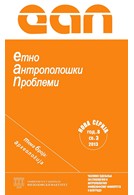Deskripcija nasuprot interpretaciji: odnos tradicionalne i savremene arheologije prema problemu impreso-barbotin ranog neolita
Description vs. Interpretation: The Attitudes of Traditional and Current Archaeology Towards the Problem of Impresso-Barbotine in the Early Neolithic
Author(s): Jasna VukovićSubject(s): Archaeology, Cultural history, Recent History (1900 till today)
Published by: Филозофски факултет, Универзитет у Београду
Keywords: pottery; impresso; barbotine; Early Neolithic; culture-historical archaeology; technology; function;
Summary/Abstract: The problem of the relationship impresso-barbotine has been chosen here, as an excellent example to illustrate the tendencies and shortcomings of the Yugoslav/Serbian archaeology during the major part of the 20th century, as well as the results forming the base for future research and new conclusions. The impresso-barbotine problem has been recognized as one of the important aspects of research into the Early Neolithic as early as in the 1950s, and formed the base for the formation of several relative chronological system. However, although the culture-historical approach is based upon detailed description and stylistic-typological analyses, these phenomena are defined and described in a number of different ways (if at all), causing great confusion. The highly simplified notion about the production and usage of ceramic ware, as well as the negligence for the functional and technological aspects, resulted in the absence of a clear statement if these techniques are in fact a form of decoration or surface treatment. On the other hand, paradoxically, these "elusive" phenomena have been taken as very precise chronological markers. The conclusions are not questionable even today, since the recent research has proven the chronological primacy of impresso over barbotine. Here, however, the shortcomings of the culture-historical method are most obvious: after the establishment of the relative chronological sequence and the identification of a change in the material culture, the reasons that induced the changes are not considered – interpretation is completely absent. However, the current archaeological trends focus upon the processes leading to changes in the material culture, the ones that cannot be explained without considering technology – from forming techniques to modes of usage. Bearing in mind that impresso, and afterwards barbotine appear on the same functional classes of pottery (storage, transportation), it may seem that the same idea motivated both manners of surface treatment – roughening so as to facilitate handling. In order to explain the reasons for the changes it is necessary to consider the forming techniques, with the most reliable indication in the chronological sequence impresso – relief impresso (plastic wheat-grain motif) – barbotine. The production of pottery with uneven surfaces rendered by impressing an instrument (impresso) and applying plastic bands, additionally fastened by impressing sharp instruments (relief impresso), is a time-consuming technique, requiring a lot of attention. It is therefore no wonder that the technique takes over of applying a layer of clay over a semi-dry surface and then arranging it with fingers – barbotine, since it is simpler and requires less work for the same effect. Current archaeological analyses of technology prove that the process of improvement of pottery forming techniques (leading to craft specialization) above all leads to simplification of procedure, in order to increase the number of vessels produced. Thus the typical assumption of traditional archaeology needs to be questioned, that the "development of culture" may be seen through the "evolution" of shapes and modes of decoration (treatment of surface), inevitably leading from simpler to more complex forms.
Journal: Етноантрополошки проблеми
- Issue Year: 8/2013
- Issue No: 3
- Page Range: 657-679
- Page Count: 23
- Language: Serbian

